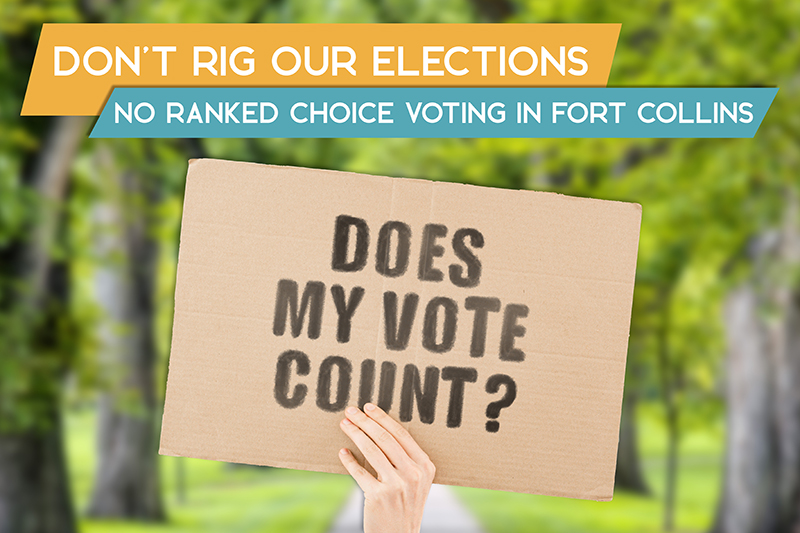Don’t Rig Our Elections

What is Ranked Choice Voting?
Ranked Choice Voting (RCV) is a risky election gimmick where voters are asked to rank multiple candidates instead of voting for one. Computers then tabulate the “winner” by a process where the lowest-ranking candidate is eliminated and the votes are re-calculated. The process repeats until a single candidate receives a “fake majority” (more on that later) and is declared a winner.
The End of “One Person, One Vote”
Ranked Choice Voting discards our the “one person, one vote” principle that our democracy was built on. Under RCV, you don’t just vote for your preferred candidate. You’re asked to rank multiple candidates. In fact, you’re penalized if you don’t vote for multiple candidates. In a five-person election, if you only like one candidate and strongly disagree with the other four, your voice is silenced.
Disenfranchisement and Suppression: The “Exhausted Ballot”
Under Ranked Choice Voting or Instant Runoff Voting, if you don’t rank all of the candidates, there’s a good chance your ballot may never be counted in the final results. It’s called an “exhausted ballot” and it’s tossed in the trash. In the close Congressional election in Maine, more than 14,000 ballots were never included in the final outcome – the voters who cast them had a first choice, but not a second or third.
In last year’s mayoral election in New York City, 140,202, ballots were tossed out and not counted. That’s 15% of the voters. The voters who cast them never had a voice. New York City Councilmember Daneek Miller, co-chair of the Black, Latino and Asian Caucus said: “It is sophisticated voter suppression, but it is voter suppression.” Hazel Dukes, president of the New York chapter of the NAACP said, “Ranked choice voting is not beneficial to minorities. It’s voter suppression.” If politics makes strange bedfellows, RCV makes very strange bedfellows: Former President Donald Trump called the whole thing a “mess” and said: “They should close the books and do it all over again, the old-fashioned way, when we had results that were accurate and meaningful.”
Back-Room Dealmaking
Under Ranked Choice Voting, factions are rewarded for flooding the ballot with stalking-horse candidates, and campaign season is rife with back-room dealmaking between candidates. There is collusion, coordinated messaging, and informal “truces” between campaigns. Voters never know the deals that are cut or the promises that are made.
Less Bipartisan Outreach; More Extremism
Under the traditional “one person, one vote” system, candidates are rewarded for forging a broad coalition. They reach out to different groups and try to bring them together behind their campaign. Ranked Choice Voting penalizes the “big tent” campaign of moderate candidates. There’s no reason for a candidate to try to talk to voters across the ideological divide and meet with diverse groups. Instead, RCV encourages each and every faction, no matter how extreme, to run their own candidate… and let the Ranked Choice Voting mathematical algorithm sort it out in the end.
No Guarantee of a Majority Winner
Advocates of Ranked Choice Voting claim that it produces a “true majority” winner. What they leave out is the “exhausted ballot” problem. Under RCV, the winner is declared based on only the ballots counted in the last round, not the “majority” of the ballots cast by all voters. – not the majority of the initial ballots cast. Studies of elections conducted WITH the Ranked Choice Voting system have turned up example after example where the final “winner” did not receive “majority support” from all the voters that cats ballots. Why? Because “exhausted ballots” are tossed along the way – along with the voices of the voters who cast them.
Not “The Will of the Voters”
In a multi-person election held under the Ranked Choice Voting system, it’s possible for someone to win nearly 50% of the vote – and beat the second-place finisher handily – and still lose the final count. In the 2010 Oakland mayoral race, the eventual winner won after nine rounds of tabulation, beating the candidate who won the most votes by receiving 25,000 second- and third-place votes. It stretches the definition of the “will of the voters” to the point of absurdity if a candidate ascends to office over a clear first-vote winner simply by being “acceptable” to enough voters.
Election Chaos
Last year, the Democratic primary for mayor in New York City was held on June 22. A week later, the Board of Elections realized they had screwed things up on election night by accidentally adding 135,000 “test” votes. A series of secretive, closed-door meetings dragged out the process, and the final results weren’t announced until July 6.